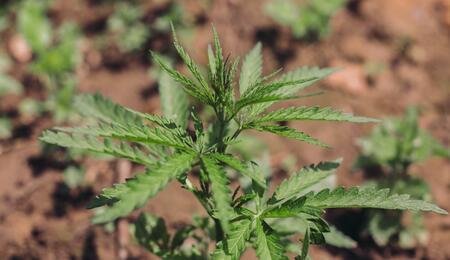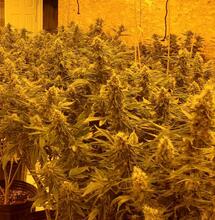Overwatering is Common Enough. Here’s How to Avoid It.

Sufficient water is necessary for the cannabis plant to thrive, but how sufficient is sufficient?
You’ve set up your grow room with lights, soil, nutrients, and you are about to germinate your seedlings to grow beautiful lush marijuana plants. One of the critical questions that pose a challenge is how to water your cannabis plant.
Yeah, you may disregard watering entirely as an issue. Who can get wrong with water? All life relies on water, including cannabis. But overwatering cannabis is one of the most common issues growers face everywhere. Cannabis plants have to receive water frequently enough, however, a lot of varieties are game, and it may depend on the type of strain you are growing. So how do you make sure your cannabis plant is watered regularly and just right? Skim through to freshen up your watering techniques.
How to water your cannabis plant?
Choose between the most practical times to water according to the temperature of the grow room. It pays to invest in a water pump, timer and set up drip lines around your gorgeous growing beauties. When you have the proper equipment, it might be the best because the timer will release water multiple times per day if necessary, even when you cannot be around to water your plants in person. The growing medium is essential to determine how much water the plant/the soil can intake.
If you are growing in pots, ensure that there are holes at the bottom of the pots so that water can escape if you make an excess of water. If you use more compact soils to grow your cannabis plants, moisture retention will be more prevalent, meaning you will need to use water less frequently.
However, this may become an issue because the soil's persistent moisture may lead to pests or nutrient deficiencies, rotting roots, and fungus. Above all, cannabis prefers soils that are airy, fluffy and well-draining. If it takes more than three days for the soil to drain out, it means there’s an issue with the soil where you are growing.
Watering needs will change over time
There are plenty of factors that determine how much water you should give to your cannabis plants. One prominent example is the stage of growth. For instance, when the plant is in its early days of transforming from seed to youngling, the water demands will be much less than the later stages. So, in the early days of the growing process, avoid flushing too much water into the soil of your cannabis growth.
Instead, go with safe solutions such as gently moistening the soil's upper layer where the seedlings are. It would probably be enough to freshen up the soil with new water pour in every 2-3 days. Just wait to see that the soil feels a bit dry to the touch before you water. The room conditions will also play a part in this case.
If the room is more dry air and higher temperature, the soil will typically dry faster, so check. Then, of course, depending on the growth stage, you may want to change the containers you use to grow your plants. A tiny pot is okay for young plants, but as the plant grows, you may need to transfer it into a larger pot. If a grown up plant is left in a tiny pot, it may be easy to drown it with too much water because the water has nowhere to go but around the roots that have, well, now occupied the whole container. Water needs to move beyond the roots in the container.
Defining watering time
Whether you are growing into soil or rockwool or coco coir may influence water timing, therefore also draining and the retention of water into the medium. If you are growing with soil and feed only water (or water and simple nutrient solutions), watering once until drip through is the standard way to do it. If you use coco mixes and have a hydroponic setup, feeding up to 3 times a day may be demanded. Then it will also depend on the lighting cycles.
Adopting watering strategies like watering one or two hours before the lights switch on or feed one hour after the lights switch off is something advisable to do. Or, if your plants are currently undergoing cycles of more lights a day (such as 18/6), less watering is advisable (like up to 3 times maximum a day). If plants are on a 12/12 regime, more watering can be considered (like up to 5 times maximum a day).
Use enzymes to break down any substrate
This will also help you clean out the root zone and growing medium. Combine enzymes with your nutrient solutions to speed up the breaking up of the nutrients. Enzymes are frequently used to boost the immunity of cannabis plants too. Use multiple brands of enzymes for your nutrient solutions. Try out a combination of Powerzyme from HESI, Cannazyme from Canna, and Sensizym from Advanced Nutrients at 3ml per liter of each. Increase the measurement to 5ml per liter of each enzyme with only plain water at the final 14 days of flushing.
Learn the signs when something is wrong with the plant
If the whole plant appears rather weak and sickly, it’s difficult to overlook this signal. It may well mean the plant is thirsty. If you know that you haven't watered your plant in a while and if the soil appears bone-dry, it's pretty evident that insufficient water is the issue. Yellowing and brown leaves might be another signal the plant lacks water.
It's okay for the plant to show off yellow leaves at the final days of blooming, but an otherwise healthy, vigorous plant shouldn't have many, if any, yellow or browning foliage. If the plant is thirsty for water but otherwise looks vigorous, its appearance should get better in a couple of hours after watering. It may be more challenging to find out when the plant has been overwatered.
One sign is when the leaves appear to be dark green and begin to curl and bend downward. So, basically, risking to underwater your plants occasionally is a more manageable problem than overwatering. The chances are the plant will recover a greater deal than with overwatering, when it becomes harder to get the situation under control.
Perform simple soil tests to check the need for water
Just place the tip of your finger slightly into the soil to see if the soil is dry or moist. While this may not tell you the amount of water inside deeper layers of the pot, you will still have an idea of how much water there is on the surface level, which is an important indicator. Another trick is to weigh the plants to check if they are watered enough. For this, you have to know the plant's weight when it is bone dry so you can make comparisons for when it’s soaked with water.
Check your pH levels and E.C. is balanced
E.C. or electrical conductivity may be a significant indicator to determine if the plant is hungry for water. E.C. levels are key not to be too low nor too high. It’s best to buy a pH and E.C. test pen and set at ease with digital measuring of both these values, especially if you are going to grow more than one cannabis plant. The nutrient uptake of a cannabis plant will be largely decided by the water source's pH and can be the difference between nutrient lockout.



